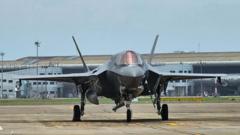Why Was a UK Fighter Jet Stuck in India for Five Weeks Before Heading to Australia?

The F-35B: A Glimpse into Advanced Military Aviation and Its Unforeseen Challenges
The world of military aviation is often shrouded in intrigue and technological marvels. One such marvel, the British F-35B, recently found itself at the center of attention due to an unexpected predicament. After being stranded at an Indian airport for over five weeks, this cutting-edge fighter jet has finally resumed its journey. This article delves into the specifics of this incident, the capabilities of the F-35B, and the implications of such unforeseen challenges in military operations.
The Incident: F-35B’s Unexpected Detour
The F-35B made headlines when it was diverted to Thiruvananthapuram airport in Kerala on June 14 after encountering severe weather conditions during a sortie over the Indian Ocean. Unfortunately, the situation became more complicated when the aircraft developed a technical snag. This development raised eyebrows and sparked widespread curiosity about how a state-of-the-art fighter jet could remain immobilized in a foreign country for an extended period.
Technical Challenges and Repairs
Following its landing, the F-35B was evaluated and deemed unfit for flight. Engineers from HMS Prince of Wales attempted to rectify the issue but could not resolve the problem. This led the UK Ministry of Defence to deploy a specialized team of 14 engineers to assess and repair the aircraft at Thiruvananthapuram airport. The extended duration of the repairs underscored the complexities involved in maintaining advanced military aircraft, especially when they encounter technical difficulties far from their home base.
The F-35B: An Overview
The F-35B is a variant of the F-35 Lightning II, developed by Lockheed Martin. It possesses several remarkable features that distinguish it from other fighter jets:
- Stealth Capabilities: The F-35B is designed with advanced stealth technology, making it difficult to detect by radar.
- Short Take-off and Vertical Landing (STOVL): This feature enables the aircraft to operate from short runways and even aircraft carriers, enhancing its operational flexibility.
- Advanced Avionics: Equipped with cutting-edge sensors and avionics, the F-35B provides pilots with superior situational awareness.
- Multirole Capabilities: The aircraft is capable of engaging in various missions, including air-to-air combat, ground attack, and reconnaissance.
Impact of the Stranded F-35B
The prolonged presence of the F-35B on Indian soil not only ignited curiosity but also raised critical questions about military logistics and operational readiness. The incident highlighted several factors:
- International Relations: The situation could have implications for UK-India relations, particularly in defense cooperation.
- Military Readiness: The incident serves as a reminder of the vulnerabilities faced by even the most advanced military assets.
- Public Perception: The “lonely F-35B” became a subject of jokes and memes, affecting the public image of the Royal Navy.
Media and Public Reaction
As the F-35B was immobilized at the airport, social media exploded with memes and jokes, portraying the aircraft as reluctant to leave the picturesque state of Kerala, often referred to as "God's own country." The imagery of the aircraft, drenched by Kerala's monsoon rains, further fueled the public’s imagination. In a world where social media can shape narratives, this incident was no exception.
The Journey to Darwin
After extensive repairs, the F-35B was finally deemed fit for flight and embarked on its journey to Darwin, Australia. The exact reason for this flight remains undisclosed, but it is speculated that it is connected to ongoing operations involving HMS Prince of Wales, the Royal Navy's flagship carrier, which has been conducting joint exercises off the Australian coast.
Operational Considerations for Military Aircraft
The F-35B incident raises important considerations regarding the operational capabilities of military aircraft, particularly when deployed far from home bases. Some of these considerations include:
- Logistical Support: Ensuring that adequate logistical support is available for maintenance and repairs during deployment.
- Emergency Procedures: Establishing robust emergency protocols to address technical issues that may arise in the field.
- Training and Readiness: Continuous training for personnel to handle unexpected situations effectively.
The Future of Military Aviation
The F-35B incident serves as a reminder of the complexities associated with modern military aviation. As technology advances, so do the challenges that accompany it. The integration of advanced systems, such as the F-35B, requires not only technical expertise but also strategic foresight in operational planning.
Innovation and Adaptation
As military forces around the world continue to innovate and adapt, it is crucial to learn from incidents like the F-35B's prolonged stay in India. The lessons learned can help enhance operational efficiency and ensure that advanced aircraft can perform at their best, even in the face of unforeseen challenges.
FAQs
What caused the F-35B to be stranded in India?
The F-35B was stranded due to severe weather conditions during a sortie, which led to a technical snag that required extensive repairs.
What are the unique features of the F-35B?
The F-35B is known for its stealth capabilities, short take-off and vertical landing (STOVL) capabilities, advanced avionics, and multirole functionalities.
How does the F-35B impact military operations?
The F-35B enhances operational flexibility and readiness, but incidents like being stranded can highlight vulnerabilities and the need for effective logistical support.
Conclusion
The journey of the F-35B from being stranded in India to taking to the skies again underscores the complexity and unpredictability of modern military aviation. As nations continue to invest in cutting-edge technology, the ability to adapt and respond to challenges will be crucial. The incident serves as a powerful reminder of the importance of logistical support and operational readiness in ensuring the effectiveness of advanced military assets.
As we reflect on this incident, one wonders how militaries worldwide will evolve their strategies to prevent similar occurrences in the future. The balance between technological advancement and operational efficiency remains a key challenge.
#F35B #MilitaryAviation #RoyalNavy
Published: 2025-07-22 06:00:20 | Category: world



